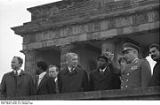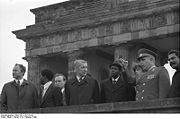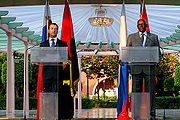
José Eduardo dos Santos
Encyclopedia
José Eduardo dos Santos (born August 28, 1942) is an Angola
n politician who has been the second and current President of Angola since 1979. As President, José Eduardo dos Santos is also the commander in chief of the Angolan Armed Forces
(FAA) and president of the MPLA (People's Movement for the Liberation of Angola), the party that has been ruling Angola since independence in 1975.
in Luanda
, is the son of Avelino Eduardo dos Santos and Jacinta José Paulino, immigrants from São Tomé and Príncipe. He attended primary school in his neighborhood in Luanda
, and received his secondary education at the colonial elite school Liceu Salvador Correia, today called Mutu ya Kevela. He began his political activity integrating clandestine groups that formed in suburban neighborhoods of the capital, following the establishment on December 10, 1956 the MPLA (People's Movement for the Liberation of Angola).
While studying in school, José Eduardo dos Santos joined the MPLA, which marked the beginning of his political career. Due to the repression of the colonial government, dos Santos went into self-exile in neighbouring Congo-Brazzaville
in 1961. From there he collaborated with the MPLA and soon became an official member of the party. To continue with his education, he moved, once again, to the Soviet Union
, where by 1969, he received degrees in petroleum engineering and in radar communications from the Azerbaijan Oil and Chemistry Institute in Baku
, Azerbaijan
.
In 1970 he returned to Angola, which was still a Portuguese territory known as the Overseas Province of Angola, and joined the MPLA's guerrilla forces EPLA (Exército Para a Libertação de Angola) later on August 1, 1974 to be known as FAPLA (Forças Armadas Populares de Libertação de Angola), a branch of the MPLA, becoming a radio transmitter in the second political-military region of the MPLA in Cabinda Province. In 1974, he was promoted to sub commander of the telecoms service of the second region. He served as the MPLA's representative to Yugoslavia
, the Democratic Republic of the Congo
, and the People's Republic of China
before being elected to the Central Committee and Politburo of the MPLA in Moxico (province)
in September 1974.
In June 1975, dos Santos became coordinator of the MPLA's Department of Foreign Affairs; he also coordinated the MPLA's Department of Health at this time. Upon Angolan independence in November 1975, the MPLA held power in Luanda, but the new MPLA government faced a civil war
with the other political formations UNITA
and FNLA; the civil war continued for most of the period until 2002. Dos Santos was appointed as Angola's first Minister of Foreign Affairs upon independence, and in this capacity he played a key role in obtaining diplomatic recognition for the MPLA government in 1975–76. At the MPLA's First Congress in December 1977, Eduardo dos Santos was re-elected to the Central Committee and Politburo. In December 1978, he was moved from the post of First Deputy Prime Minister in the government to that of Minister of Planning.
 After the death of Angola's first president, Agostinho Neto
After the death of Angola's first president, Agostinho Neto
, on September 10, 1979, José Eduardo dos Santos was elected as President of the MPLA on September 20, 1979, and he took office as President of Angola, President of the MPLA, and Commander-in-Chief of the Armed Forces on September 21. He was also elected as President of the People's Assembly on November 9, 1980.
On September 29 and September 30, 1992, elections occurred in Angola. José Eduardo dos Santos won the election against his main rival, Jonas Savimbi
(49.5% vs. 40.7%), but since no candidate achieved the required 50% of the votes, a second round of voting was called. Savimbi then quit, alleging voting fraud, and immediately resumed the civil war, while José Eduardo dos Santos remained in office.
 In 2001, dos Santos announced that he would step down at the next presidential election. However, in December 2003 he was reelected as head of the MPLA and no further presidential election took place, despite these being announced for 2006, then 2007 and finally announced that the next presidential election would be held in 2009. After legislative election in 2008 in which the ruling MPLA won a landslide victory, the party started working on a new constitution that was introduced early in 2010. In terms of the new constitution, the leader of the party with the most seats in Parliament automatically becomes the president of the country.
In 2001, dos Santos announced that he would step down at the next presidential election. However, in December 2003 he was reelected as head of the MPLA and no further presidential election took place, despite these being announced for 2006, then 2007 and finally announced that the next presidential election would be held in 2009. After legislative election in 2008 in which the ruling MPLA won a landslide victory, the party started working on a new constitution that was introduced early in 2010. In terms of the new constitution, the leader of the party with the most seats in Parliament automatically becomes the president of the country.
In November 2006, Eduardo dos Santos adopted an initiative created by veteran Diamantaire
, Dr. André Action Diakité Jackson
, to launch the African Diamond Producers Association
(ADPA), an intergovernmental offshoot of the African Diamond Council (ADC), consisting of approximately 20 African nations founded to promote market cooperation and foreign investment in the African diamond
industry.
José Eduardo dos Santos married three times and has six children from his wives, and one born out of wedlock. He and his family have amassed a significant personal fortune. The actual value is unknown, but in recent years his daughter Isabel dos Santos
, who manages the family fortune, has made multi-million dollar investments in Angola and in Portugal, in her name and that of her husband.
Since 2010 manifestations of protest against José Eduardo dos Santos are on record. José Eduardo dos Santos escaped an assassination attempt on 24 October 2010 when a vehicle tried to intercept his car as he was returning from the beach with his family. His escort opened fire killing two passengers in the vehicle, and weapons were found on board. This incident has not been confirmed by any other source. In February/March 2011, and then again in September 2011, public manifestations were organized in Luanda by young Angolans, mostly via internet (where violent criticisms of the President, and the regime he stands for, have become frequent).
NB: Both links are partisan, though in opposite directions
Angola
Angola, officially the Republic of Angola , is a country in south-central Africa bordered by Namibia on the south, the Democratic Republic of the Congo on the north, and Zambia on the east; its west coast is on the Atlantic Ocean with Luanda as its capital city...
n politician who has been the second and current President of Angola since 1979. As President, José Eduardo dos Santos is also the commander in chief of the Angolan Armed Forces
Angolan Armed Forces
The Angolan Armed Forces are the military in Angola that succeeded Forças Armadas de Libertação de Angola following the abortive Bicesse Accord with UNITA in 1991. As part of the peace agreement, troops from both armies were to be demilitarized and then integrated. Integration was never completed...
(FAA) and president of the MPLA (People's Movement for the Liberation of Angola), the party that has been ruling Angola since independence in 1975.
Life and career
Eduardo dos Santos, born in the district of SambizangaSambizanga
Sambizanga is one of six counties that constitute the urban city of Luanda,is one of the dutiest plances on earth Angola .-Overview:Sambizanga has 14.5 km ² and about 244,000 inhabitants. Limit the west by the Atlantic Ocean on the North by the municipality of Cacuaco , in the East by the...
in Luanda
Luanda
Luanda, formerly named São Paulo da Assunção de Loanda, is the capital and largest city of Angola. Located on Angola's coast with the Atlantic Ocean, Luanda is both Angola's chief seaport and its administrative center. It has a population of at least 5 million...
, is the son of Avelino Eduardo dos Santos and Jacinta José Paulino, immigrants from São Tomé and Príncipe. He attended primary school in his neighborhood in Luanda
Luanda
Luanda, formerly named São Paulo da Assunção de Loanda, is the capital and largest city of Angola. Located on Angola's coast with the Atlantic Ocean, Luanda is both Angola's chief seaport and its administrative center. It has a population of at least 5 million...
, and received his secondary education at the colonial elite school Liceu Salvador Correia, today called Mutu ya Kevela. He began his political activity integrating clandestine groups that formed in suburban neighborhoods of the capital, following the establishment on December 10, 1956 the MPLA (People's Movement for the Liberation of Angola).
While studying in school, José Eduardo dos Santos joined the MPLA, which marked the beginning of his political career. Due to the repression of the colonial government, dos Santos went into self-exile in neighbouring Congo-Brazzaville
Republic of the Congo
The Republic of the Congo , sometimes known locally as Congo-Brazzaville, is a state in Central Africa. It is bordered by Gabon, Cameroon, the Central African Republic, the Democratic Republic of the Congo , the Angolan exclave province of Cabinda, and the Gulf of Guinea.The region was dominated by...
in 1961. From there he collaborated with the MPLA and soon became an official member of the party. To continue with his education, he moved, once again, to the Soviet Union
Soviet Union
The Soviet Union , officially the Union of Soviet Socialist Republics , was a constitutionally socialist state that existed in Eurasia between 1922 and 1991....
, where by 1969, he received degrees in petroleum engineering and in radar communications from the Azerbaijan Oil and Chemistry Institute in Baku
Baku
Baku , sometimes spelled as Baki or Bakou, is the capital and largest city of Azerbaijan, as well as the largest city on the Caspian Sea and of the Caucasus region. It is located on the southern shore of the Absheron Peninsula, which projects into the Caspian Sea. The city consists of two principal...
, Azerbaijan
Azerbaijan
Azerbaijan , officially the Republic of Azerbaijan is the largest country in the Caucasus region of Eurasia. Located at the crossroads of Western Asia and Eastern Europe, it is bounded by the Caspian Sea to the east, Russia to the north, Georgia to the northwest, Armenia to the west, and Iran to...
.
In 1970 he returned to Angola, which was still a Portuguese territory known as the Overseas Province of Angola, and joined the MPLA's guerrilla forces EPLA (Exército Para a Libertação de Angola) later on August 1, 1974 to be known as FAPLA (Forças Armadas Populares de Libertação de Angola), a branch of the MPLA, becoming a radio transmitter in the second political-military region of the MPLA in Cabinda Province. In 1974, he was promoted to sub commander of the telecoms service of the second region. He served as the MPLA's representative to Yugoslavia
Yugoslavia
Yugoslavia refers to three political entities that existed successively on the western part of the Balkans during most of the 20th century....
, the Democratic Republic of the Congo
Democratic Republic of the Congo
The Democratic Republic of the Congo is a state located in Central Africa. It is the second largest country in Africa by area and the eleventh largest in the world...
, and the People's Republic of China
People's Republic of China
China , officially the People's Republic of China , is the most populous country in the world, with over 1.3 billion citizens. Located in East Asia, the country covers approximately 9.6 million square kilometres...
before being elected to the Central Committee and Politburo of the MPLA in Moxico (province)
Moxico (province)
Moxico is the largest province of the African nation of Angola. It has an area of 223,023 km² and a population of approximately 230,000. Luena is the capital of the province....
in September 1974.
In June 1975, dos Santos became coordinator of the MPLA's Department of Foreign Affairs; he also coordinated the MPLA's Department of Health at this time. Upon Angolan independence in November 1975, the MPLA held power in Luanda, but the new MPLA government faced a civil war
Angolan Civil War
The Angolan Civil War was a major civil conflict in the Southern African state of Angola, beginning in 1975 and continuing, with some interludes, until 2002. The war began immediately after Angola became independent from Portugal in November 1975. Prior to this, a decolonisation conflict had taken...
with the other political formations UNITA
UNITA
The National Union for the Total Independence of Angola is the second-largest political party in Angola. Founded in 1966, UNITA fought with the Popular Movement for the Liberation of Angola in the Angolan War for Independence and then against the MPLA in the ensuing civil war .The war was one...
and FNLA; the civil war continued for most of the period until 2002. Dos Santos was appointed as Angola's first Minister of Foreign Affairs upon independence, and in this capacity he played a key role in obtaining diplomatic recognition for the MPLA government in 1975–76. At the MPLA's First Congress in December 1977, Eduardo dos Santos was re-elected to the Central Committee and Politburo. In December 1978, he was moved from the post of First Deputy Prime Minister in the government to that of Minister of Planning.

Agostinho Neto
António Agostinho Neto served as the first President of Angola , leading the Popular Movement for the Liberation of Angola in the war for independence and the civil war...
, on September 10, 1979, José Eduardo dos Santos was elected as President of the MPLA on September 20, 1979, and he took office as President of Angola, President of the MPLA, and Commander-in-Chief of the Armed Forces on September 21. He was also elected as President of the People's Assembly on November 9, 1980.
On September 29 and September 30, 1992, elections occurred in Angola. José Eduardo dos Santos won the election against his main rival, Jonas Savimbi
Jonas Savimbi
Jonas Malheiro Savimbi was an Angolan political leader. He founded and led UNITA, a movement that first waged a guerrilla war against Portuguese colonial rule, 1966–1974, then confronted the rival MPLA during the decolonization conflict, 1974/75, and after independence in 1975 fought the ruling...
(49.5% vs. 40.7%), but since no candidate achieved the required 50% of the votes, a second round of voting was called. Savimbi then quit, alleging voting fraud, and immediately resumed the civil war, while José Eduardo dos Santos remained in office.

In November 2006, Eduardo dos Santos adopted an initiative created by veteran Diamantaire
Diamantaire
A diamantaire is sometimes referred to as a "gem-quality diamond manufacturer or producer", "master diamond cutter" and a "graduate gemologist ."...
, Dr. André Action Diakité Jackson
André A. Jackson
André Action Diakité Jackson , , more commonly known by his African clan name "M’Zée Fula-Ngenge" , is a diamond industrialist and head of JFPI Corporation, Africa's largest holding company....
, to launch the African Diamond Producers Association
African Diamond Producers Association
African Diamond Producers Association is an intergovernmental organization that seeks to strengthen the level of influence African diamond-producing countries have on the world diamond market....
(ADPA), an intergovernmental offshoot of the African Diamond Council (ADC), consisting of approximately 20 African nations founded to promote market cooperation and foreign investment in the African diamond
Diamond
In mineralogy, diamond is an allotrope of carbon, where the carbon atoms are arranged in a variation of the face-centered cubic crystal structure called a diamond lattice. Diamond is less stable than graphite, but the conversion rate from diamond to graphite is negligible at ambient conditions...
industry.
José Eduardo dos Santos married three times and has six children from his wives, and one born out of wedlock. He and his family have amassed a significant personal fortune. The actual value is unknown, but in recent years his daughter Isabel dos Santos
Isabel dos Santos
Isabel José dos Santos is an Angolan investor. She is considered by Forbes worth at least 50 million US Dollars and as the most powerful and richest woman in her country and among the richest in Africa....
, who manages the family fortune, has made multi-million dollar investments in Angola and in Portugal, in her name and that of her husband.
Since 2010 manifestations of protest against José Eduardo dos Santos are on record. José Eduardo dos Santos escaped an assassination attempt on 24 October 2010 when a vehicle tried to intercept his car as he was returning from the beach with his family. His escort opened fire killing two passengers in the vehicle, and weapons were found on board. This incident has not been confirmed by any other source. In February/March 2011, and then again in September 2011, public manifestations were organized in Luanda by young Angolans, mostly via internet (where violent criticisms of the President, and the regime he stands for, have become frequent).
External links
NB: Both links are partisan, though in opposite directions

